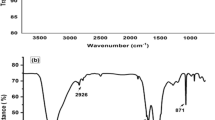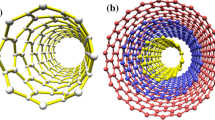Abstract
Biomaterial nano architectures have become an eminent building block in bio-electronics. A green nano composite of reduced graphene oxide (RGO) supported cellulose microfiber (CMF) was used in an electrochemical assay of nitrobenzene (NB). The synthesized composite was characterized via Fourier Transform Infra-Red spectra, Raman spectroscopy, Scanning electron microscopy and EDX spectroscopy. The CMF-RGO film modified glassy carbon electrode showed promising electrocatalytic activity towards NB reduction in terms of high sensitivity (733.8 µA mM−1 cm−2), broad dynamic range (0.2–927.7 µM), and a decent limit of detection (88 nM). On top of this, the composite was used to analyze the water samples collected from river, sewage, and pond aquarium with satisfactory results. In addition, the fabricated sensor matrix offers good durability and appreciable reproducibility. Electrocatalytic performance of the constructed assay was comparable with the reported NB sensors matrices.






Similar content being viewed by others
References
Allen MJ, Tung VC, Kaner RB (2009) Honeycomb carbon: a review of graphene. Chem Rev 110:132–145
Balasubramanian P, Velmurugan M, Chen SM et al (2017a) Optimized electrochemical synthesis of copper nanoparticles decorated reduced graphene oxide: application for enzymeless determination of glucose in human blood. J Electroanal Chem 807:128–136
Balasubramanian P, Thirumalraj B, Chen SM et al (2017b) Electrochemical determination of isoniazid using gallic acid supported reduced graphene oxide. J Electrochem Soc 164:H503–H508
Boukhvalov DW, Katsnelson MI (2008) Modeling of graphite oxide. J Am Chem Soc 130:10697–10701
Dong C, Lu J, Qiu B et al (2018) Developing stretchable and graphene-oxide-based hydrogel for the removal of organic pollutants and metal ions. Appl Catal B Environ 222:146–156
Feng Y, Zhang X, Shen Y et al (2012) A mechanically strong, flexible and conductive film based on bacterial cellulose/graphene nanocomposite. Carbohydr Polym 87:644–649
Gupta R, Rastogi PK, Ganesan V et al (2017) Gold nanoparticles decorated mesoporous silica microspheres: a proficient electrochemical sensing scaffold for hydrazine and nitrobenzene. Sens Actuat B 239:970–978
Habibi Y (2014) Key advances in the chemical modification of nanocelluloses. Chem Soc Rev 43:1519–1542
Han D, Yan L, Chen W et al (2011) Cellulose/graphite oxide composite films with improved mechanical properties over a wide range of temperature. Carbohydr Polym 83:966–972
Holder JW (1999a) Nitrobenzene potential human cancer risk based on animal studies. Toxicol Ind Health 15:5
Holder JW (1999b) Nitrobenzene carcinogenicity in animals and human hazard evaluation. Toxicol Ind Health 15:5
Holder J, Jinot J (1998) National center for environmental assessment, Washington. Office, Washington, EPA/600/R-95/100
Kafy A, Sadasivuni KK, Akther A et al (2015) Cellulose/graphene nanocomposite as multifunctional electronic and solvent sensor material. Mater Lett 159:20–23
Kariuki VM, Fasih-Ahmad SA, Osonga FJ et al (2016) An electrochemical sensor for nitrobenzene using π-conjugated polymer-embedded nanosilver. Analyst 141:2259–2269
Karthik R, Karikalan N, Chen SM (2017) Rapid synthesis of ethyl cellulose supported platinum nanoparticles for the non-enzymatic determination of H2O2. Carbohydr Polym 164:102–108
Karuppiah C, Muthupandi K, Chen SM et al (2015) Green synthesized silver nanoparticles decorated on reduced graphene oxide for enhanced electrochemical sensing of nitrobenzene in waste water samples. RSC Adv 5:31139–31146
Kim CJ, Khan W, Kim DH et al (2011) Graphene oxide/cellulose composite using NMMO monohydrate. Carbohydr Polym 86:903–909
Liang F, Liu B, Deng Y et al (2011) Preparation and characterization of attapulgite-silver nanocomposites, and their application to the electrochemical determination of nitrobenzene. Microchim Acta 174:407
Luo L, Wang X, Ding Y et al (2010) Electrochemical determination of nitrobenzene using bismuth-film modified carbon paste electrode in the presence of cetyltrimethylammonium bromide. Anal Methods 2:1095–1100
Ma J, Zhang Y, Zhang X et al (2012) Sensitive electrochemical detection of nitrobenzene based on macro-/meso-porous carbon materials modified glassy carbon electrode. Talanta 88:696–700
Marcano DC, Kosynkin DV, Berlin JM (2010) Improved synthesis of graphene oxide. ACS Nano 4:806–4814
Neo CY, Ouyang J (2013) Ethyl cellulose and functionalized carbon nanotubes as a co-gelator for high-performance quasi-solid state dye-sensitized solar cells. J Mater Chem A 1:14392–14401
Ouyang W, Sun J, Memon J et al (2013) Scalable preparation of three-dimensional porous structures of reduced graphene oxide/cellulose composites and their application in supercapacitors. Carbon 62:501–509
Palanisamy S, Ramaraj SK, Chen SM et al (2017) A novel Laccase biosensor based on laccase immobilized graphene-cellulose microfiber composite modified screen-printed carbon electrode for sensitive determination of catechol. Sci Rep 7:41214
Qi B, Lin F, Bai J et al (2008) An ordered mesoporous carbon/didodecyldimethylammonium bromide composite and its application in the electro-catalytic reduction of nitrobenzene. Mater Lett 62:3670–3672
Qi H, Schulz B, Vad T, Liu J et al (2015) Novel carbon nanotube/cellulose composite fibers as multifunctional materials. ACS Appl Mater Interfaces 7:22404–22412
Qiu B, Li Q, Shen B et al (2016) Stöber-like method to synthesize ultradispersed Fe3O4 nanoparticles on graphene with excellent Photo-Fenton reaction and high-performance lithium storage. Appl Catal B Environ 183:216–223
Rameshkumar P, Viswanathan P, Ramaraj R (2014) Silicate sol–gel stabilized silver nanoparticles for sensor applications toward mercuric ions, hydrogen peroxide and nitrobenzene. Sens Actuat B 202:1070–1077
Rastogi PK, Krishnamoorthi S, Ganesan V (2014) Palladium nanoparticles incorporated polymer-silica nanocomposite based electrochemical sensing platform for nitrobenzene detection. Electrochim Acta 147:442–450
Sadasivuni KK, Kafy A, Kim HC et al (2015) Reduced graphene oxide filled cellulose films for flexible temperature sensor application. Synth Met 206:154–161
Velmurugan M, Karikalan N, Chen SM et al (2017) Studies on the influence of β-cyclodextrin on graphene oxide and its synergistic activity to the electrochemical detection of nitrobenzene. J Colloid Interface Sci 490:365–371
Velusamy V, Palanisamy S, Chen SM et al (2017) Graphene dispersed cellulose microfibers composite for efficient immobilization of hemoglobin and selective biosensor for detection of hydrogen peroxide. Sens Actuat B. https://doi.org/10.1016/j.snb.2017.05.041
Vimlesh C, Jaesung P, Young C et al (2010) Waterdispersible magnetite-reduced graphene oxide composites for Arsenic removal. ACS Nano 7:3979–3986
Wang GY, Yang LL, Li Y et al (2013) A luminescent 2D coordination polymer for selective sensing of nitrobenzene. Dalton Trans 42:12865–12868
Weng Z, Su Y, Wang DW et al (2011) Graphene–cellulose paper flexible supercapacitors. Adv Energy Mater 1:917–922
Yadav DK, Ganesan V, Sonkar PK et al (2016) Electrochemical investigation of gold nanoparticles incorporated zinc based metal-organic framework for selective recognition of nitrite and nitrobenzene. Electrochim Acta 200:276–282
Zhang Y, Zeng L, Bo X et al (2012a) Electrochemical study of nitrobenzene reduction using novel Pt nanoparticles/macroporous carbon hybrid nanocomposites. Anal Chim Acta 752:45–52
Zhang X, Liu X, Zheng W et al (2012b) Regenerated cellulose/graphene nanocomposite films prepared in DMAC/LiCl solution. Carbohydr Polym 88:26–30
Zhang Y, Bo X, Luhana C et al (2013) A partially reduced C 60-grafted macroporous carbon composite for the enhanced electrocatalysis of nitroaromatic compounds. RSC Adv 3:17300–17306
Zhang Y, Bo X, Nsabimana A et al (2014) Fabrication of 2D ordered mesoporous carbon nitride and its use as electrochemical sensing platform for H2O2, nitrobenzene, and NADH detection. Biosens Bioelectron 53:250–256
Zhang C, Zhang RZ, Ma YQ et al (2015) Preparation of cellulose/graphene composite and its applications for triazine pesticides adsorption from water. ACS Sustain Chem Eng 3:396–405
Zhao ZQ, Chen X, Yang Q et al (2012) Selective adsorption toward toxic metal ions results in selective response: electrochemical studies on a polypyrrole/reduced graphene oxide nanocomposite. Chem Commun 48:2180–2182
Acknowledgments
The authors gratefully acknowledge the financial support of the Ministry of Science and Technology, Taiwan through Contract Nos: MOST106-2113-M-027-003 and MOST106-2221-E-182-021. The financial support from the Chung Gung Memorial Hospital through Contract No. BMRP 280 to B.S. Lou is also acknowledged.
Author information
Authors and Affiliations
Corresponding authors
Rights and permissions
About this article
Cite this article
Balasubramanian, P., Balamurugan, T.S.T., Chen, SM. et al. A simple architecture of cellulose microfiber/reduced graphene oxide nanocomposite for the electrochemical determination of nitrobenzene in sewage water. Cellulose 25, 2381–2391 (2018). https://doi.org/10.1007/s10570-018-1719-1
Received:
Accepted:
Published:
Issue Date:
DOI: https://doi.org/10.1007/s10570-018-1719-1




